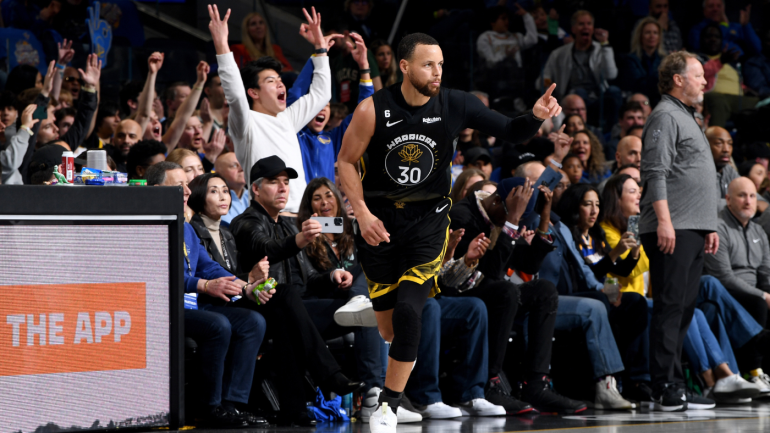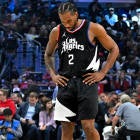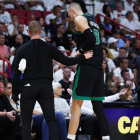
After storming back from an eight-point deficit over the final two minutes of regulation, the Golden State Warriors had possession on a sideline out-of-bounds, in a tie game, with 1.9 seconds remaining vs. the visiting Milwaukee Bucks on Saturday.
Stephen Curry was tabbed with being the inbound passer.
This has long been a point of frustration for me: teams using their most dangerous shooter as the inbound passer against short-clock situations. Anyone who watches any amount of NBA basketball has surely heard a hundred broadcasters tell you that the in-bounder is the most dangerous guy on the floor. They love to tell you this, as if they are revealing some gem of intelligence of which nobody else is aware.
Newsflash: Everyone is aware. Including the defense. The chances of catching an NBA defense napping against an elite shooter as the in-bounder in a short-clock situation are not high. What you're doing, as a coach making this decision, is pretty much willingly pushing your most dangerous shooter way down the list of possible shooters on a final play.
The Hawks did this with Trae Young a lot under Nate McMillan. It's strange. Young is short. He isn't going to have particularly good vision if anyone with length guards the pass. Yes, he's a natural passer and a trusted decision-maker, but he's also the guy you want taking the shot, or at least serving as a mobile decoy. Get it in and quickly get it back, you say? That's where the short clock comes in. The shorter it is, the more likely it is that your best shooter becomes a spectator. In the case of Curry and the Warriors on Saturday night, there were, again, just 1.9 seconds left.
If Curry, who was scorching hot down the stretch of the fourth quarter, was going to have time to pass the ball in, make a move to get open, get a pass back and get a clean shot off, all in 1.9 seconds, it was going to have to come together instantaneously.
As it happened, the high-wire design actually worked.
And the Warriors might've had time to fully execute it.
But it was cutting it too close, and Draymond Green called his own number instead.
It went like this: Curry inbounded to Draymond Green, whose defender, Brook Lopez, was sagged off Green for pretty obvious reasons. If Green, a 33-percent low-volume 3-point shooter, wants to pull the trigger on a potential game-winning shot instead of Curry or Klay Thompson or Jordan Poole, by all means, fire away.
However, there's a rub to playing that far off a non-shooter like Green, which is that it frees him up to serve as an impromptu, unoccupied ball screener. Green does this all the time. He's amazing at it. He'll receive a pass, see his defender six feet away, and give it right back to Curry or Poole or Thompson with a variation of a dribble handoff and flow right into a ball screen. He hits the man covering the shooter, Green's man is too far back to help, and a great shooter comes off with a great look.
This was Green's plan on Saturday.
Curry would inbound and sprint straight in for a quick dribble handoff with Green, who would then screen Curry's man, Jrue Holiday. With Lopez too far away to provide support for the screened Holiday, Curry, if everything went according to plan, would come off for a clean look at a game-winner.
But it didn't go according to plan. Holiday, a wonderfully gifted and hyper-intelligent defender anticipated this exact action, immediately jumping to the topside of Curry upon the inbound pass, thus cutting off his runaround route to Green.
This is where it gets good. Curry, an equally intelligent and instinctual offensive mover, countered Holiday's counter by taking one hard step in the direction Holiday expected him to go, and then, as soon as Holiday started his momentum going one way, planting and flaring back the other way.
It worked. Watch the play in full below, and you'll see that Curry pops wide open just as Green decides to pull the trigger himself.
Draymond went for it.
— Hoop Central (@TheHoopCentral) March 12, 2023
pic.twitter.com/ryTDwUIQHS
"I told Steph, like, yo, if you can get over the top, my man gonna be down the floor and I can hit you," Green told reporters afterward. "As soon as he threw it, Jrue jumped on the topside and I knew I was firing."
Steve Kerr said there were "a few different options" on the play design, and that "the way Lopez played, Draymond made the right read and popped out."
Indeed, Green popped out high to receive the inbound pass, and from there, his anticipatory chemistry with Curry was the weapon. So on this one play, you had three supremely cerebral basketball players all more or less predicting what was going happen before it actually happened.
Holiday predicted that Curry was going to sprint high for a dribble handoff, and jumped it. Green predicted that he would be able to screen Holiday with his defender sagged back. Curry predicted that Holiday would cut off the topside and went the other way.

CBS Sports HQ Newsletter
Your Ultimate Guide to Every Day in Sports
We bring sports news that matters to your inbox, to help you stay informed and get a winning edge.
Thanks for signing up!
Keep an eye on your inbox.
Sorry!
There was an error processing your subscription.
Incredibly high-level stuff in the blink of an eye, and under normal circumstances, Green would be on the same page with Curry on that counter flare cut. But with just 1.9 seconds to go, as soon as he saw Holiday jump high, he didn't want to risk running out of time trying to hit Curry. So he fired. And he damn near made it.
"It felt amazing," Green said of the potential game-winning shot. "I can't believe it bounced out. I haven't felt a shot feel that good in a while. It felt incredible. But, it's all good."
It was all good, indeed, because the Warriors still got the win. But on that play, that was a win for Holiday and the Bucks. Curry was open for a game-winning shot and Green took it instead. This is the risk of the best shooter on the floor, and in this case, the best shooter in history, serving as the passer against a low clock. He might not get the chance to actually take the shot.
In this case, he didn't. But the Warriors still managed to win, so it didn't cost them. Either way, what a cool example of all the thinking, all the anticipation and counters and re-counters, that can be squeezed into less than two seconds of NBA action.






















